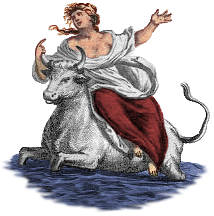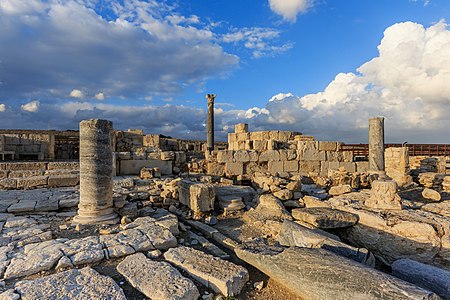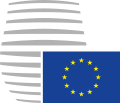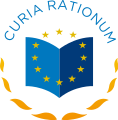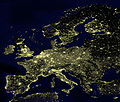
Back بوابة:الاتحاد الأوروبي Arabic Portal:Avropa İttifaqı Azerbaijani প্রবেশদ্বার:ইউরোপীয় ইউনিয়ন Bengali/Bangla Portal:Unió Europea Catalan Portál:Evropská unie Czech Portal:Den Europæiske Union Danish Portal:Europäische Union German Πύλη:Ευρωπαϊκή Ένωση Greek Portal:Unión Europea Spanish Teemasivu:Euroopan unioni Finnish
Introduction
The European Union (EU) is a supranational political and economic union of 27 member states that are located primarily in Europe. The Union has a total area of 4,233,255 km2 (1,634,469 sq mi) and an estimated total population of over 449 million. The EU has often been described as a sui generis political entity combining the characteristics of both a federation and a confederation. Containing 5.8% of the world population in 2020, EU member states generated a nominal gross domestic product (GDP) of around US$16.6 trillion in 2022, constituting approximately one sixth of global nominal GDP. Additionally, all EU states except Bulgaria have a very high Human Development Index according to the United Nations Development Programme. Its cornerstone, the Customs Union, paved the way to establishing an internal single market based on standardised legal framework and legislation that applies in all member states in those matters, and only those matters, where the states have agreed to act as one. EU policies aim to ensure the free movement of people, goods, services and capital within the internal market; enact legislation in justice and home affairs; and maintain common policies on trade, agriculture, fisheries and regional development. Passport controls have been abolished for travel within the Schengen Area. The eurozone is a group composed of the 20 EU member states that have fully implemented the economic and monetary union and use the euro currency. Through the Common Foreign and Security Policy, the union has developed a role in external relations and defence. It maintains permanent diplomatic missions throughout the world and represents itself at the United Nations, the World Trade Organization, the G7 and the G20. Due to its global influence, the European Union has been described by some scholars as an emerging superpower. In 2012, the EU was awarded the Nobel Peace Prize. The United Kingdom became the only member state to leave the EU, in 2020; ten countries are aspiring or negotiating to join it. (Full article...) Selected article The eurozone, officially euro area, refers to a currency union among the European Union member states that have adopted the euro as their sole official currency. The Eurosystem, headed by the European Central Bank, is responsible for monetary policy within the Eurozone. The Eurozone has 19 members, with a further six states and territories using it as their sole currency. It circulates widely beyond that, and has started to serve as a reserve currency. Based on official estimates of 2007 GDP, the Eurozone is the largest economy in the world. Selected picturePhotograph credit: Alexander Savin Kourion is an ancient city-state on the southwestern coast of the island of Cyprus, located near modern Limassol, that existed from antiquity until the Middle Ages. Built in the 12th century BC by Mycenaeans who took part in the Trojan War, Kourion was later controlled by the Greeks, Romans, and Byzantines. The settlement was placed on a 70-metre-high (230 ft) cliff to ensure the safety of its citizens. The modern archaeological site is managed by the Department of Antiquities of Cyprus and includes the ruins of the stadium and the sanctuary of Apollo Hylates. This photograph depicts the ruins of Kourion's agora, a central public space in the city-state.
Did you know?...that Monaco, San Marino, and Vatican City all mint their own euro coins, with their own national symbols on the back, despite not being EU members? Selected cityBucharest is the capital city and industrial and commercial centre of Romania. It is located in the southeast of the country, and lies on the banks of the Dâmboviţa River. By European standards Bucharest is not an old city, its existence first being referred to by scholars as late as 1459. Since then it has gone through a variety of changes, becoming the state capital of Romania in 1862 and steadily consolidating its position as the centre of the Romanian mass media, culture and arts. Its eclectic architecture is a mix of historical, interbellum, Communist-era, and modern. In the period between the two World Wars, the city's elegant architecture and the sophistication of its elite earned Bucharest the nickname of the "Paris of the East" or "Little Paris". According to the 2011 census, Bucharest proper has a population of 1,883,425. There are approximately 2.3 million inhabitants in the greater metropolitan area. Economically, the city is by far the most prosperous in Romania and is one of the main industrial centres and transportation hubs of Eastern Europe. As the most important city in Romania, Bucharest also has a broad range of educational facilities. General imagesThe following are images from various European Union-related articles on Wikipedia.
TopicsFeatured contentFeatured articles
Featured lists
Featured contentGood articles
CategoriesRelated portalsAssociated WikimediaThe following Wikimedia Foundation sister projects provide more on this subject:
Discover Wikipedia using portals |


